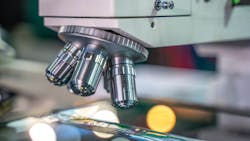Modified microscope slides show promise for disease detection
The detection of cancer and potentially other diseases could become much easier and much more successful, thanks to the transformation of conventional microscope slides to something more sophisticated.
Developed by a team at La Trobe University (Melbourne, Australia), smart microscope slides can help biological structures and cells to assume colors and make it easier to detect disease within samples.1
According to the researchers, which, along with La Trobe, included a team from the Peter MacCallum Cancer Centre (also in Melbourne), biological samples are largely transparent and “nearly invisible when viewed using a standard optical microscope” using standard slides. To date, producing colored images under the microscope involves stains or dyes, which tend to alter the properties of a sample.
“Looking for just a few cancer cells amongst hundreds of healthy cells is like trying to look for a needle in a haystack,” says La Trobe University Professor Brian Abbey, who developed the modified slide alongside Research Fellow Dr. Eugeniu Balaur. “What our technology aims to do is to make this process much easier and quicker for the pathologist by identifying abnormal cancer cells from a field of thousands.”
Specifically, the team’s relatively simple modifications to the slide’s surface at the nanoscale level allow cells and biological structures to generate “a striking color contrast” and could ultimately detect cancer and potentially other diseases quickly.
Modification components
Incorporated in the new slide is “layers of finely printed metals on the surface of the glass to manipulate the interaction of light with cells,” the study notes, and “the result is massively enhanced contrast when viewing tissue under the microscope.” The researchers compare the contrast to “going from black-and-white television to color.”
They demonstrated that “colorimetric histology images can be generated using full-sized, plasmonically active microscope slides.” The slides exhibited subtle changes in the dielectric constant, which resulted in a color contrast between different types of cells when samples were placed on them. According to the study, “the colorimetric output of the image pixels is compared to conventional histopathology.”
The new technique, which the researchers call histoplasmonics, can distinguish neoplastic cells from normal breast tissue during the earliest stages of a tumor’s development in a mouse mammary tumor model. The researchers then applied the method to human diagnostic tissue, leading them to “validate its utility in distinguishing normal epithelium, usual ductal hyperplasia, and early-stage breast cancer.”
“For the first time, I saw cancer cells just popping up at me,” says Belinda Parker, an associate professor at the Peter MacCallum Cancer Centre who participated in the study. “We could easily distinguish cancer cells from the surrounding normal tissue. The [modified] slide also distinguishes cancer from other non-cancerous abnormalities in the breast, which has great promise for early cancer diagnosis.”
REFERENCE
1. E. Balaur et al., Nature, 598, 65–71 (2021).
About the Author
Justine Murphy
Multimedia Director, Digital Infrastructure
Justine Murphy is the multimedia director for Endeavor Business Media's Digital Infrastructure Group. She is a multiple award-winning writer and editor with more 20 years of experience in newspaper publishing as well as public relations, marketing, and communications. For nearly 10 years, she has covered all facets of the optics and photonics industry as an editor, writer, web news anchor, and podcast host for an internationally reaching magazine publishing company. Her work has earned accolades from the New England Press Association as well as the SIIA/Jesse H. Neal Awards. She received a B.A. from the Massachusetts College of Liberal Arts.

